by Wine Owners
Posted on 2015-03-16
With Robert Parker handing over the reins of Bordeaux Primeurs tasting to Neal Martin, what are the implications?
The first, most obvious, change is Neal’s palate.
However objective a critic may be, his or her palate and personal preferences inevitably play a big part. Where Parker excelled was at getting his impressions across in a particularly accessible and descriptive way; not easy when tasting barrel samples. The temptation is to describe a wine in its elemental state elementally, which isn't that interesting to read. He described its future, and over the years demonstrated he was rather good at that.
His personal preferences may have veered towards a sunnier style of wine, but he tended to let the wine buyer know if a wine was stylistically towards one end of the spectrum or another. But it must be very hard to award a great score to a wine that doesn’t move you viscerally, and to that extent personal preferences must come into play.
Martin’s tasting preferences are naturally more European than Parker’s, and is perhaps more likely to be dazzled by finesse and complexity over power, texture and rich fruit. This is a gross oversimplification for sure, but perhaps suffice to say his evaluations will be his own.
The second is winemaking trends.
The trend back towards a more classical form of winemaking is already underway (allied to far better vineyard husbandry than was broadly the case when Parker started out – he is often attributed with raising standards). Use of new oak is being moderated at many Chateaux, and régisseurs are looking at ways to fully express and nuance their amazing terroirs, sub-plots and micro-climates whilst making the most of Bordeaux’s inherent ability to bear and bottle the most age-worthy wines in the world.
The tendency of the late 1980s and 1990s towards making and showing the kind of wines proprietors thought would garner the best scores early on is on the wane. If the world’s leading critics and evaluators of young Bordeaux favour a finer-boned vernacular, this will be reflected in the market, which is more likely than not to reward those styles of wine with the greatest demand.
The third change is context.
Back in the early 1980s there was no Internet, market transparency was therefore limited and the market was much narrower than today’s. Can another critic, however good, assume the same degree of importance and purchasing influence over a market in the way that Parker has achieved? If so, will they come from Europe or do they have to be American? Or Asian?
Will crowdsourcing views and reviews become a proxy for the next leading critic of his or her generation, a perspective that arises with the growing importance of the Internet? I wonder. Some may argue that buyers are too ready in our online age to trust the word of a virtual room-full of complete strangers over the words of an advisor or friend. Whilst such principles may work well for holiday destinations or white goods manufacturers, it’s tougher to see how this will ultimately prevail for the finest of fine wine. How experienced is the taster, do they have a bank of reference points in respect of tasting young wines, and can they draw parallels between what a wine tasted like when in barrel compared with 10-15 years on? Can they recognise the future evolution of a young wine, see similarities and differences, then context (and visualise) the next young wine they taste accordingly? What does it mean when experienced tasters say that great wine is born great? What does great taste like? What’s the palate preference of each taster; where on the spectrum do they sit?
That’s an awful lot of questions to ask of a crowd, especially when most of them have day jobs. Broadly, people may not care about all that of course; but people into their fine wine, and making spending decisions based on the judgement of others, will care. That’s why evaluators of fine wine such as Neal Martin, Jancis Robinson, Stephen Tanzer, Antonio Galloni, Tim Atkin, Will Lyons, and many other talented writers (see here) matter so much.
What could be somewhat significant in turning reputation and influence into market impact is the business model deployed. What I wonder is this: with the Internet capable of coalescing huge audiences and showing the true - often massively underestimated - size of market niches, will blanket subscription firewalls allow wine writers to maximise market influence?
How experts in general monetise their high value content may yet change over the next few years, perhaps in a parallel way that the music business experienced a profound shift from selling records to selling bums on seats and festival tickets. Will the experiential become the bigger money-spinner? How the world’s critics engage with their audience and allow them an element of participation and dialogue may prove decisive for the next Parker, if there is to be one. Being social web savvy can only but help.
The fourth change may be the end to ‘wait and see’.
If the Chateaux knew Robert Parker was coming to Bordeaux, they might hold off from releasing until his scores were known, and the job of negociant and merchant alike was simplified, if sometimes a little delayed.
When Parker didn't come to town within a few months of the new vintage, the market reflected the collective views of the wine industry that had tasted samples most frequently (producers, courtiers, negociants, importers) and added a dose of realism to do with the macro-economic context. Price differentials within a set of wines (e.g. First Growths) were narrower. So, famously, 1990 was priced cheaply in the recession of 1991 as was 2008 in the post-Lehmann, financially sclerotic environment of 2009.
In the short term at least, all the leading critics will turn up to taste on time and publish on time. The extent to which they will collectively or individually influence prices (and demand) remains to be seen, but it would be more surprising if they didn’t have at least some bearing on the market. Producers are more likely to have made up their mind on pricing based on their qualitative assessments early on, and perhaps we shall all be spared interminably long campaigns.
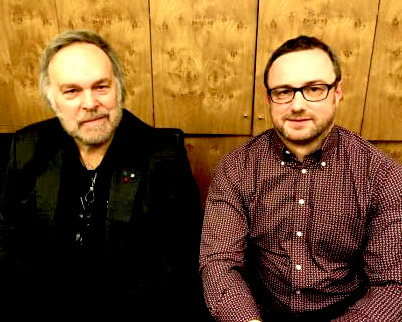
by Wine Owners
Posted on 2015-03-11
A week into March, activity on the fine wine exchange has been steady off the back of record highs in January and February. The focus has clustered around older vintages of Bordeaux, in line with market expectations which indicate that apart from ‘perfect’ wines there is as yet modest appetite for 2009 and 2010, let alone more recent vintages.
In vintages which are attracting more favour, however, successful bids have been closer than ever to market price, and seem to indicate the beginnings of wider price improvement.
The WO First Growth Index shows improvement still from December, though shedding a point from early February’s level, perhaps following a slight trading lull post Chinese New Year.
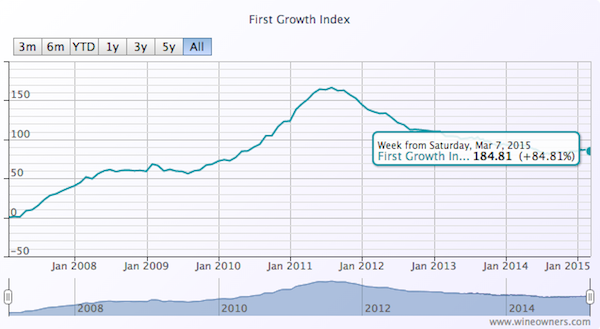
With that in mind, worth noting that there are still many offers that are below either market level, or best UK market price, and by no means are these all Bordeaux. In fact, a ‘best 20’ offers includes extraordinary variety at best-in-market prices: Insignia 1996, Grange 2009, Rousseau Clos des Ruchottes 2000, and big bottles of Ausone 2005 and La Mission 2001.
| Wine |
Pack size |
Cases |
In Bond |
Pack Price |
Current market price |
| Joseph Phelps Winery Insignia - 1996 |
12x75 |
1 |
IB |
£1,100.00 |
£1539.24 |
| Chateau Ausone - 2005 |
1x300 |
2 |
IB |
£3,000.00 |
£3424.2 |
| Chateau Angelus - 2005 |
6x150 |
1 |
IB |
£2,200.00 |
£2556.72 |
| Penfolds Wines Grange Bin 95 Shiraz - 2009 |
6x75 |
10 |
IB |
£1,550.00 |
£1879.92 |
| Chateau l'Evangile - 2005 |
6x150 |
1 |
IB |
£1,250.00 |
£1565.76 |
| Domaine Meo-Camuzet Nuits-Saint-Georges Aux Boudots - 1996 |
12x75 |
1 |
IB |
£2,250.00 |
£2496 |
| Chateau de Valandraud - 2005 |
12x75 |
2 |
IB |
£1,400.00 |
£1638.6 |
| Frederic Magnien Chambertin Clos de Beze - 2009 |
12x75 |
1 |
IB |
£1,000.00 |
£1236.36 |
| Roberto Voerzio La Serra Barolo - 1998 |
12x75 |
3 |
IB |
£900.00 |
£1107 |
| Jean Chauvenet Nuits-Saint-Georges Les Damodes - 2004 |
12x75 |
1 |
IB |
£250.00 |
£456 |
| Chateau La Mission Haut-Brion - 2001 |
3x300 |
1 |
IB |
£1,195.00 |
£1400.04 |
| Roberto Voerzio Brunate Barolo - 1998 |
12x75 |
2 |
IB |
£800.00 |
£993.72 |
| Chateau Moulin Saint-Georges - 2005 |
12x75 |
1 |
IB |
£310.00 |
£483.24 |
| Chateau Clinet - 2009 |
12x75 |
1 |
IB |
£1,875.00 |
£2040.36 |
| Paul Jaboulet Aine La Chapelle Hermitage - 2006 |
6x75 |
1 |
IB |
£310.00 |
£429.06 |
| Falletto di Bruno Giacosa Falletto Barolo Riserva - 2001 |
6x75 |
1 |
IB |
£1,250.00 |
£1366.14 |
| Domaine Armand Rousseau Clos des Ruchottes Monopole - 2000 |
12x75 |
1 |
IB |
£3,190.00 |
£3305.28 |
| Les Forts de Latour - 2004 |
12x75 |
1 |
IB |
£1,175.00 |
£1289.88 |
| Domaine Henri Bonneau Cuvee Speciale Chateauneuf du Pape - 1998 |
6x75 |
1 |
IB |
£1,900.00 |
£2012.22 |
| Roberto Voerzio Cerequio Barolo - 1998 |
12x75 |
2 |
IB |
£850.00 |
£952.92 |
| Domaine Alain Hudelot Noellat Chambolle-Musigny - 2007 |
12x75 |
1 |
DP |
£300.00 |
£401.16 |
by Wine Owners
Posted on 2015-03-05
You’ve got to laugh. A friend of mine contacted a company called Noble Rock, ostensibly on behalf of his father who had a fine wine collection. My friend’s name is Peter Bevan.
Having requested a valuation from Noble Rock, and offering to sell his wine through them, they called him back offering to sell carbon credits. As interesting a segue as I have ever come across...
Once the conversation was brought back to the question of his father’s wine, he was told that his wine collection had gone up in value substantially. This surprised Peter since he hasn’t yet provided details of the wines to them.
So how could they possibly know what his wines were worth? The Man from the Rock patiently explained to Peter that they knew because every time a wine was bought en primeur the details of the buyer and their wines were entered onto a Register – which they had looked up and that was why they knew about his wines!
Valuations that were subsequently discussed were sky-high, predicated on the well-practised advance fee fraud of paying a sum of money up-front to get the wine to Hong Kong, where it would be sold at auction at a massive premium to market. In this case the advance fee was justified on the basis of it being a VAT payment of 10%. Peter queried, if it was VAT, why it was only 10% of the value and not 20%; the answer being that only half of the VAT due was payable straight away. A novel concept that would interest HMRC I’m sure.
It was all so entertaining and extraordinary. But there is a serious side since people are being taken for a royal ride. Otherwise these people wouldn’t exist would they? The message is clear, do not take calls from people you don’t know selling by phone. And if anyone suggests there’s a way to sell wine at a market premium (check the market level price on www.wineowners.com), they are conning you. It simply doesn’t work that way.
Oh, and what happened to my friend Peter? Well, his name wasn’t really Peter; his real name is Mark. Mark Bevan, of Nexus Wine Collections. He runs one of the UK’s most successful specialist fine wine storage businesses, and had contacted Noble Rock because a number of his clients had been approached by phone spinning their yarns of criminal intent.
by Wine Owners
Posted on 2015-03-03
As if to make Jean-Michel Laporte, estate manager of Chateau La Conseillante, feel at home, the walls of auction room G2 at Bonhams on New Bond Street are covered in deep purple fabric. Not only were those walls a perfect match for the violette which so strikingly makes La Conseillante's capsules instantly recognisable, but also recalled Jean-Michel's city of origin, Toulouse, which made it's medieval fortune on the back of the highly prized dye it extracted from violets. Life has a certain symmetry to it, just like the wines of La Conseillante.
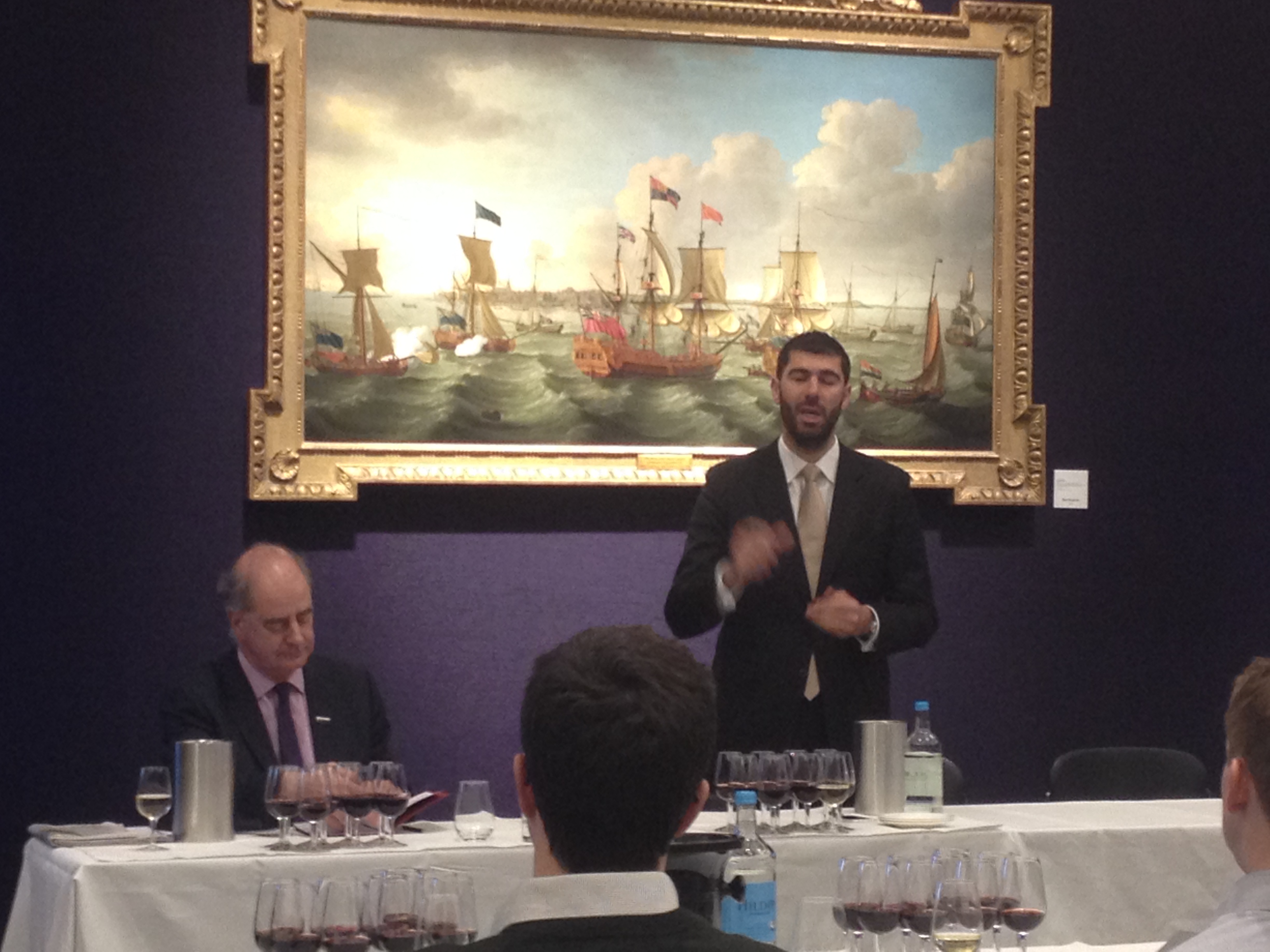
Jean-Michel comes across as proud though modest - "we just make wine" - eschews recent trends for biodynamics in a humid, Atlantic weather system, yet recognises that there are some things that past generations practised which have significance today, such as following the lunar cycles.
The tasting kicked off with the great duo of 2010 and 2009; the 2011 that was to have been served being misdirected en route to the auction room. Champagne in hand to slate our thirst, this hardly seemed like a great loss, yet by the end of the tasting presumptions of greater and lesser vintages had been challenged. 2010
Licorice and floral notes on the nose, with hints of pepper. Poised fruit, of a vivid, floral character washes over the palate, at once grippy and sweet. Impeccable balance, somehow belying it's 14.5 degrees of alcohol with a remarkable finesse and purity. This really is great wine for the very long term. 2009 Darker fruited nose announcing a warmer style. A deep well of fruit, in the cassis and blackberry spectrum. A powerful entry and confit fruited mid-palate. The heat of the year lends it a modern dimension.
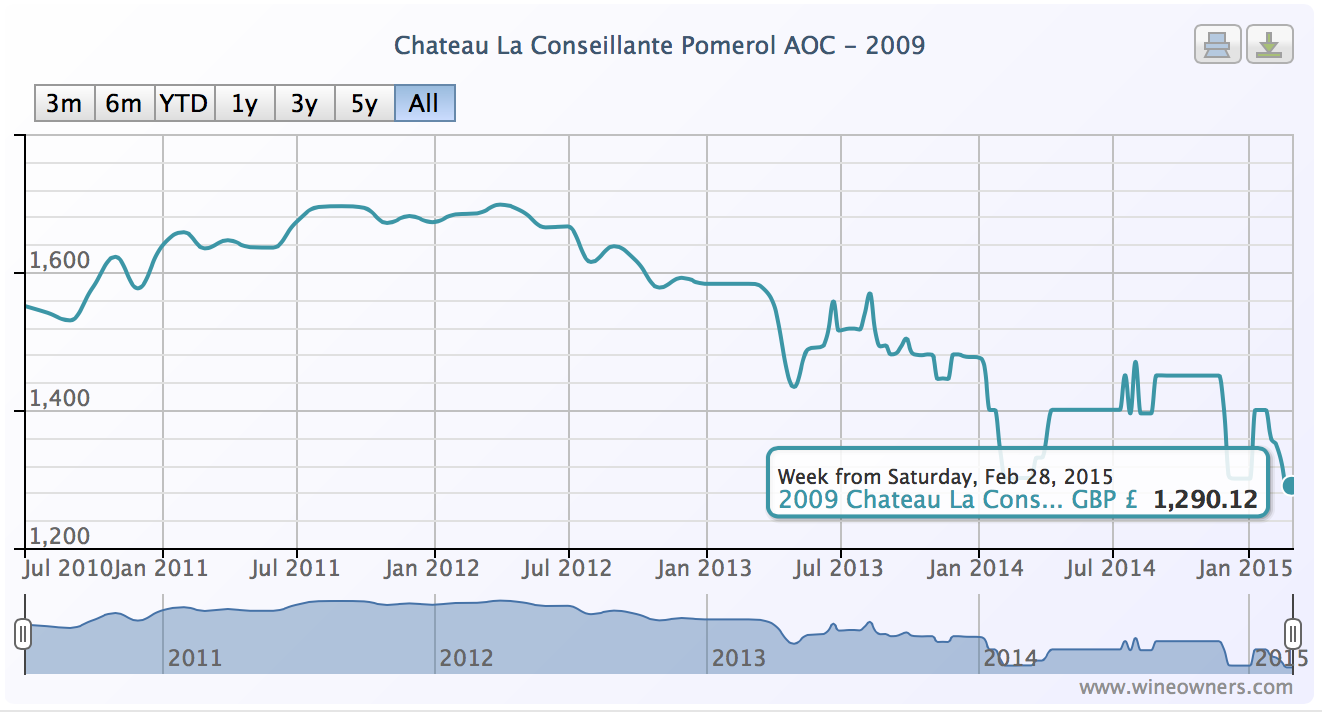
2008 Explosive nose of macerated fruit, aromatic and playful. On the palate, elegant and cool, grippy. Balanced, symmetrical wine with substance to the cleansing fruit, salivant then hints of earthiness on the finish. Classically dry at the end.
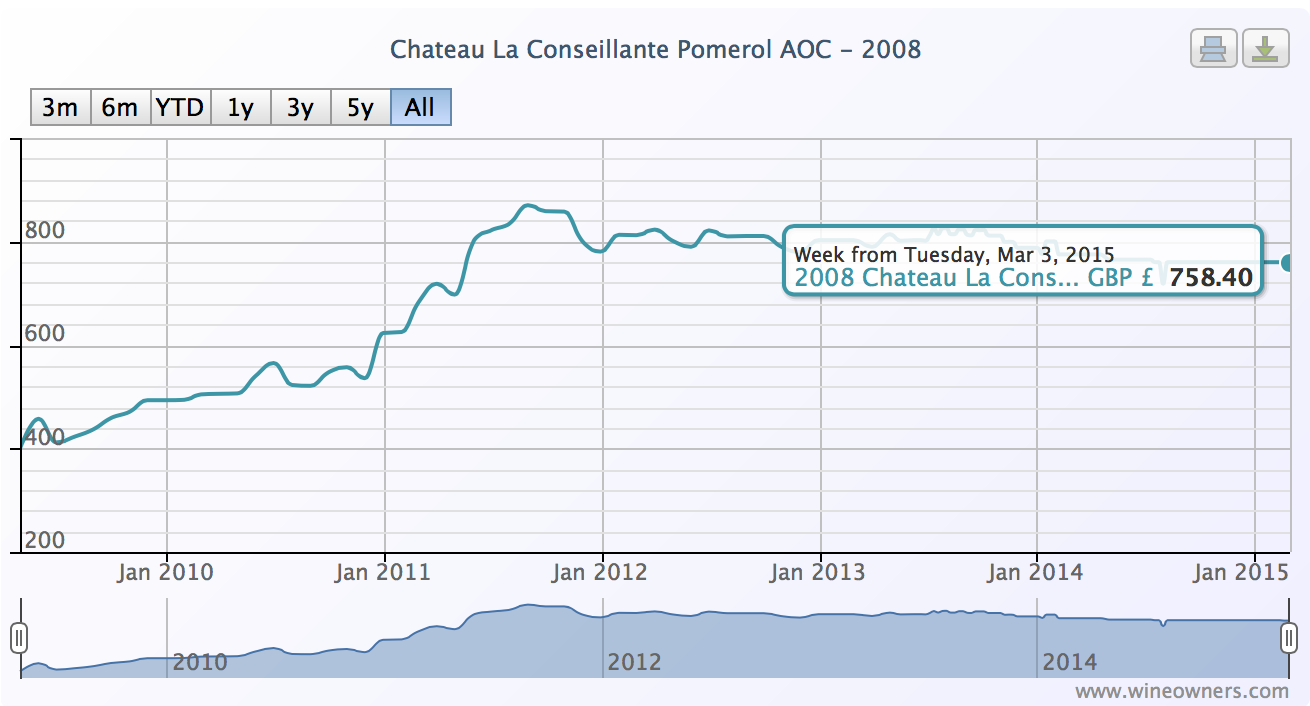
2006 Refined, liquory nose with dusting of pepper. Textural wine, with a meaty, gamey mid palate and iodine notes. 30 minutes later, a revelation, with purer fruit, sappy and intense with great tension and length. Wow. Exciting already, but some way short of early maturity.
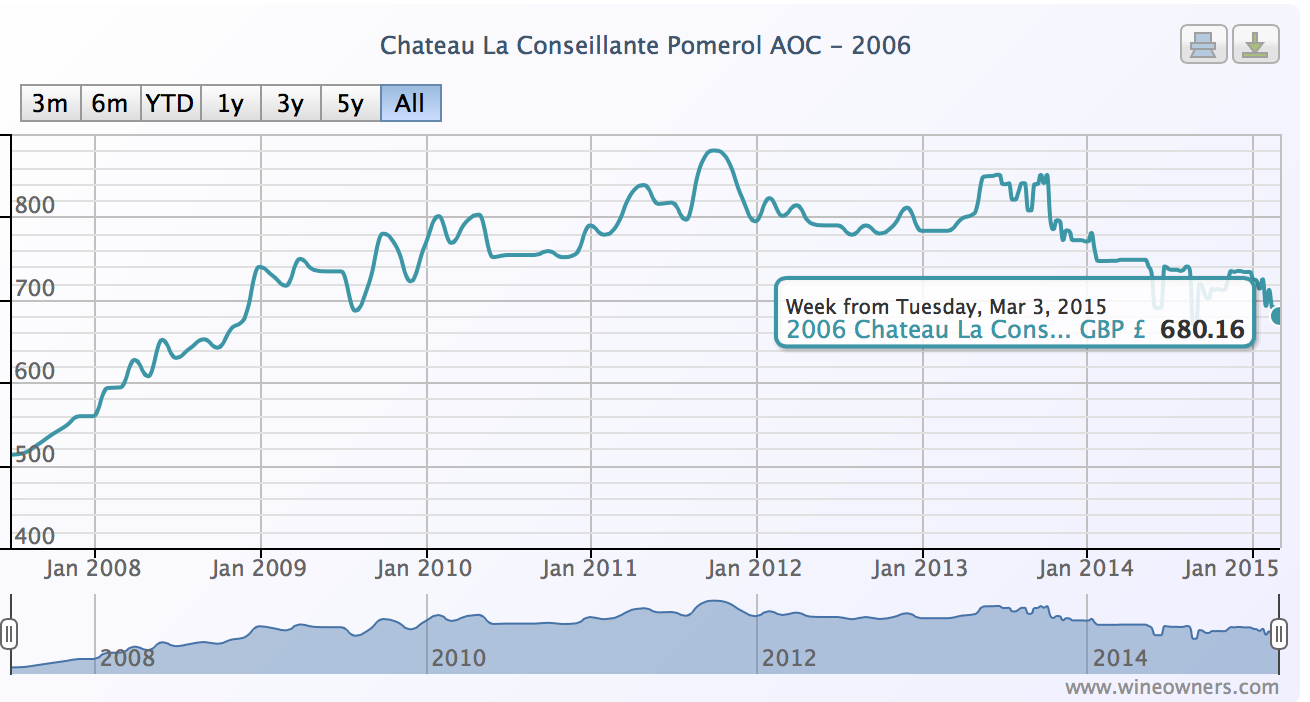
2005 Finely chiselled nose, cool, peppery. The palate shows a velvety smooth entry, aromatic and gamey flavours, with super intensity of grainy fruit. Mouthwatering and lifted mid palate, very progressive, and a very, very long finish.
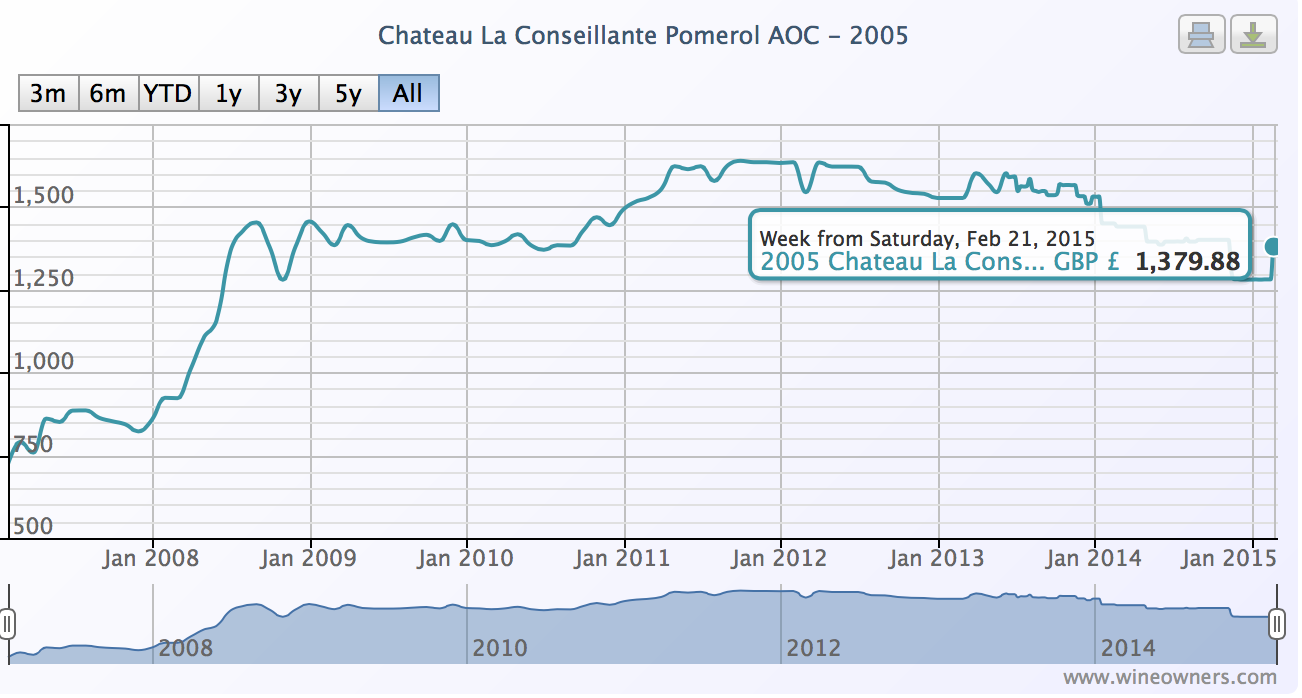
2001 Earthy nose, aromatic fruit and a touch of pepper. More evolved, with iodine on the mid palate ahead of intense lifted fruit. Firm and decidedly mineral. 2000 Elegant, sweet nose rather like a maturing Barolo or Cote de Nuits Cru. Followed by a red-fruited, warm Burgundian palate. Very pretty, a predictably ripe and satisfying mid-palate, leading to a sappy insistent finish.

1985 Perfumed nose of sandalwood. Soft-fruited and scented wood notes on the palate, truffled, autumnal and with a subtle smoked character. Utterly alluring and delicious.
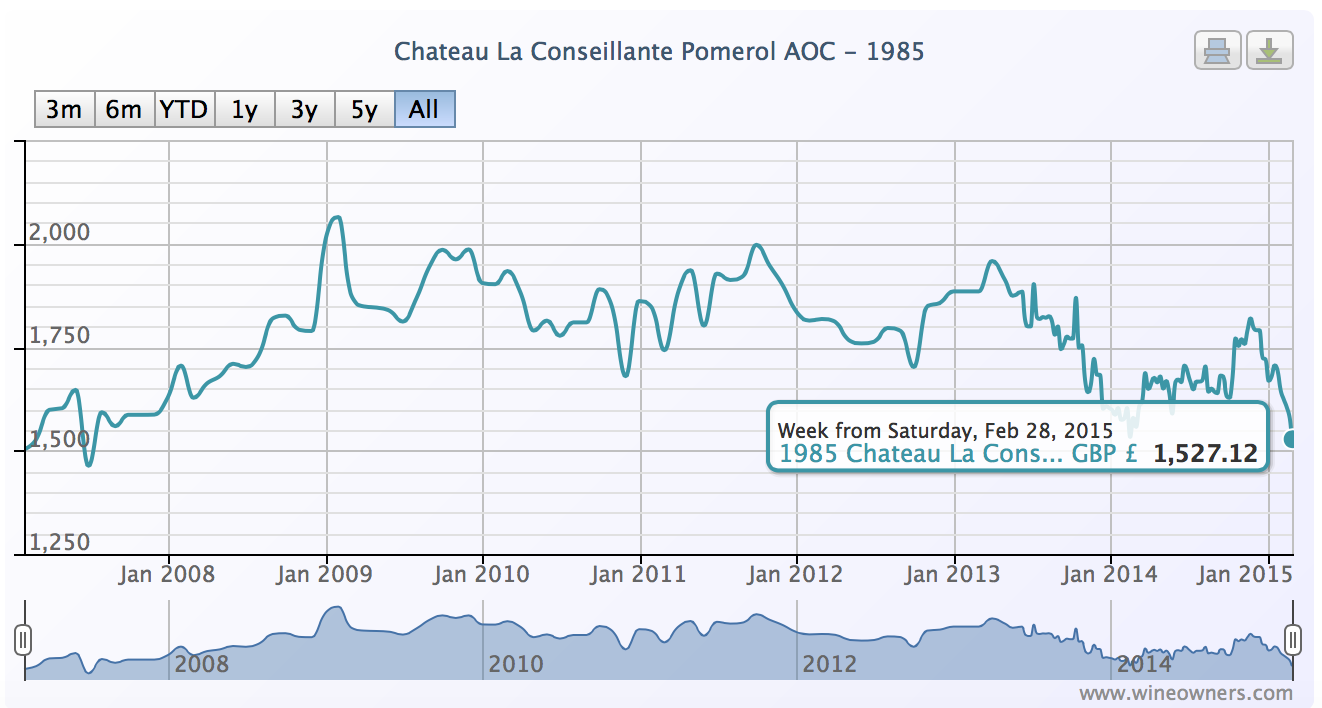
1982 Deeper perfumed nose and camphor. A similarly velvety, coating sensation of fruit like the 2005, then gamey notes, tobacco notes and a more pronounced smokiness. Crystalline finish, again sappy and very, very persistent.
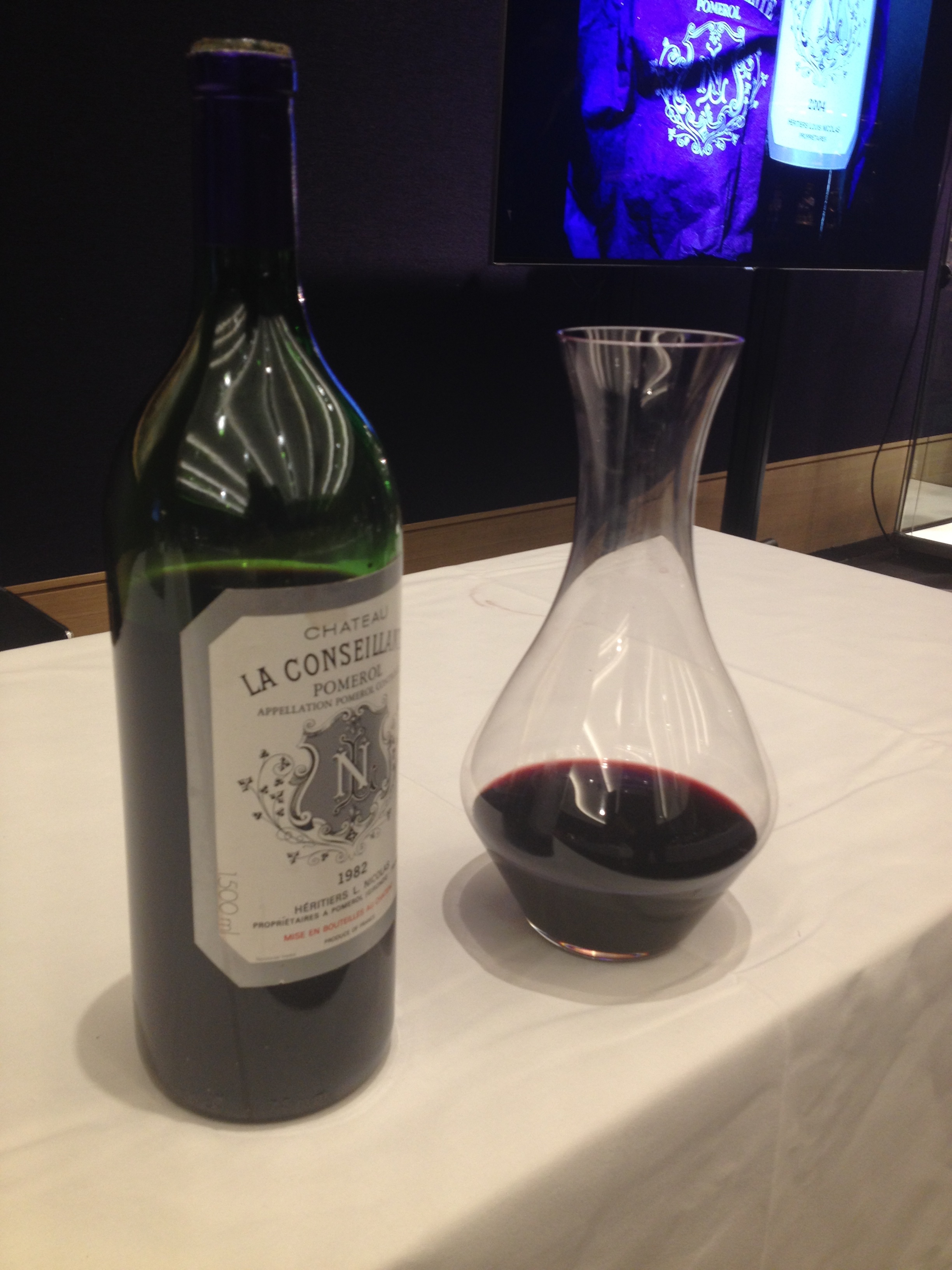
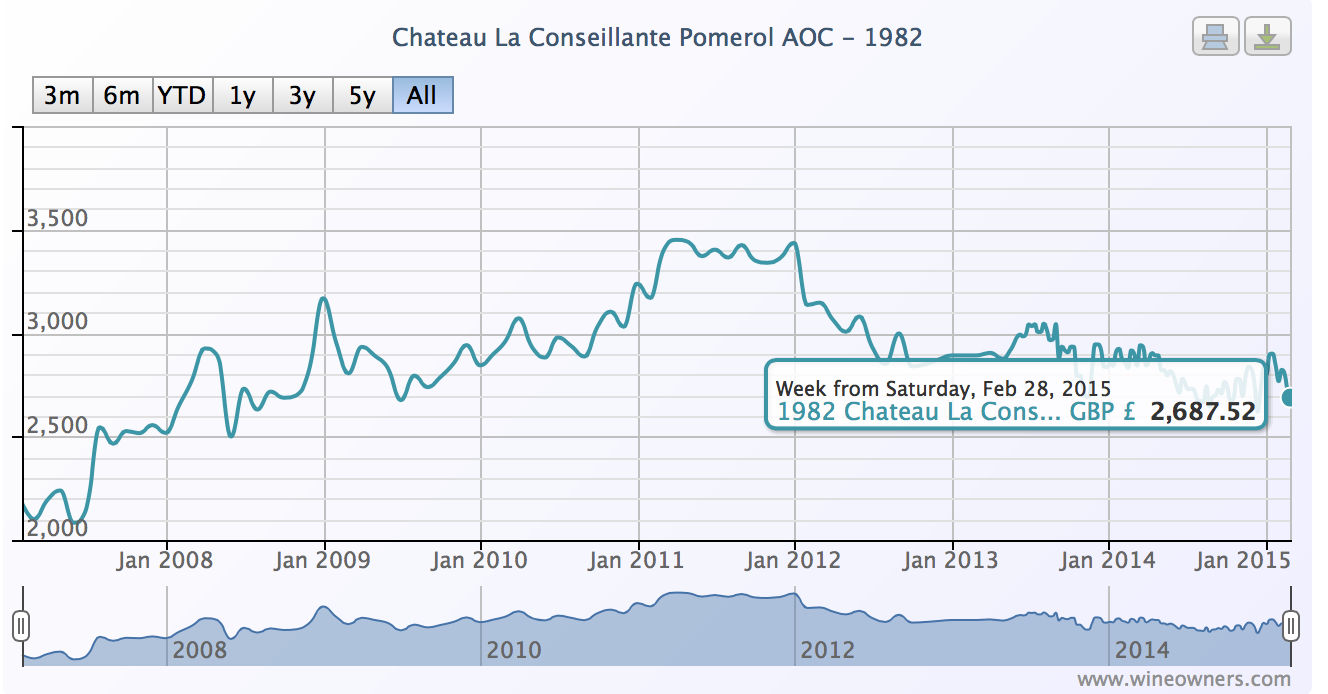
by Wine Owners
Posted on 2015-03-01
Today's excellent Matter of Taste event at the Saatchi gallery put on by the Robert Parker organisation highlighted to me that wines from so-called vintages overshadowed by great vintages may give far superior early to medium term pleasure than those more illustrious, fêted siblings.
Thinking back a year or so to previous tastings, Pontet Canet comes to mind. Take your pick from 2002, 2004 or 2006 for wines which today deliver great visceral pleasure (although the latter vintages are youthful) - whether you favour asian-spiced, sweetly grained and plump or delineated and pure fruit the choice (and preference) is yours. The dual powerhouses of 2009 and 2010 are incredibly dense wines, but today seem brutalistic and impregnable. Impressive as hell, they remain ébauches that Time, the master craftsman, is yet to shape.
A wonderful Masterclass led by Neal Martin and Alexandre Thienpont, winemaker and proprietor of Vieux Chateau Certan, further illustrated the point.
The surprise of the tasting was Vieux Chateau Certan 2006, which preceded the 2005.
A composed, peppery and dark-scented nose announced a medium weight, finely-woven, textured wine. Beautifully integrated, showing a firm core coated with a fine, sweet gloss, and a medium-long, insistent finish.
A delight to drink now, whilst giving the warmer, controlled, classically sauvage (iodine/ meaty) character of the 2005 another 5-10 years to achieve its unquestionable potential. In contrast the 2006 has an elegance and purity all of its own, and at a 20% discount to the 2005.
It's worth looking out for 'VCC' 2006 on the back of this showing. It's equally tempting to seek out more 2006s more generally, a vintage that had garnered some good reviews at first release, but which suffered in comparison to the more successful 2005 vintage across the Bordeaux region and due to release prices that were far too close to those of the previous year. Now almost a decade on, the fine, compelling character of the year is clear, and the pricing looks very fair.
Martin highlighted that Pomerol and St Emilion had enjoyed a particularly successful vintage in 2006. With that in mind, you may wish to check out the fine wine exchange for the following:
Lafleur Petrus
La Conseillante
Hosanna
Ausone
Marzelle
The wine of the 2006 vintage, Robert Parker and Jancis Robinson both proposed (in a rare show of unanimity), was Mission Haut Brion. Surely the price will never be as realistic as it is today, at around £1,250-1,350? (55%+ down from it's idiotic opening price that proved to be damaging to its secondary market performance). At least now this great wine is within reach of more wine lovers.
Mission Haut Brion
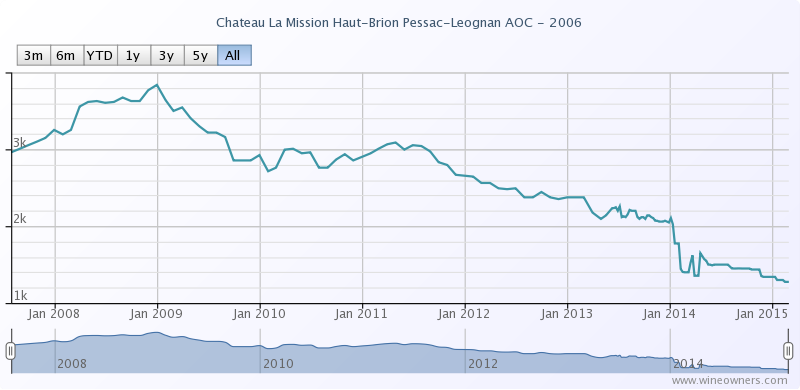
A somewhat under-the-radar La Mission, the 2006 was generally overlooked following the brilliance of the 2005. A young, dense purple-hued wine that is developing beautifully, it exhibits notes of Asian plum sauce, charcoal, barbecue smoke, roasted meats, graphite and background oak. Full-bodied with good acidity, moderate tannin and a vigorous, powerful youthfulness, the 2006 will age more quickly than the 2005, but it still requires another 5-8 years of cellaring. Anticipated Maturity: 2014-2035. (RP 2012)
Nick Martin

